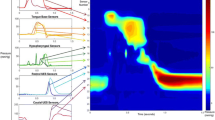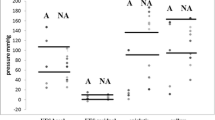Abstract
Recent technological advances in manometry, including solid state transducers and computerized analysis, allows for reliable interpretation of intraluminal pharyngeal pressures. Simultaneous videoradiography (barium swallow) provides fluoroscopic control of the manometric sensors (videomanometry), thereby eliminating the uncertainty of sensor dislocation during laryngeal elevation. This is the first study describing normal manometric parameters in videomanometry during barium swallow. Seven manometric parameters and six videoradiographic parameters were analyzed. We included 25 nondysphagic volunteers with normal videoradiographic parameters in the study. The examination was performed in an upright physiologic position during 10-ml barium and dry swallows. Mean resting pressure in the upper esophageal sphincter was 89.6±32.6 (±2 SD) mmHg. Mean residual pressure during relaxation of the upper esophageal sphincter was 7.2±8.0 (±2 SD) mmHg during barium swallow and 3.8±6.2 (±2 SD) mmHg during dry swallow. The mean duration of upper esophageal sphincter relaxation was 601±248 (±2 SD) msec. The mean peristaltic contraction of the upper esophageal sphincter was 253.8±142.8 (±2 SD) mmHg. Fourteen (56%) of the 25 had a measurable intrabolus pressure (mean 33.2±17.3 mmHg) at the level of the inferior pharyngeal constrictor. A specific finding was discovered when the epiglottis tilts down hitting the manometric sensor. This epiglottic tilt was identified in 7 subjects (28%) and caused pressures of around 600 mmHg. A standardized manometric technique is important in videomanometry, and normal values as described in this study are essential in clinical use.
Similar content being viewed by others
References
Ekberg O, Wahlgren O: Dysfunction of pharyngeal swallowing. A cineradiographic investigation in 854 dysphagical patients. Acta Radiol Diagn 26:389–395, 1985
Castell JA, Castell DO. Modern solid state computerized manometry of the pharyngoesophageal segment. Dysphagia 8:270–275, 1993
Dodds WJ, Kahrilas PJ, Dent J, Hogan WJ: Considerations about pharyngeal manometry. Dysphagia 1:209–214, 1987
McConnel FMS, Cerenko D, Hersh T, Weil LJ: Evaluation of pharyngeal dysphagia with manofluorography. Dysphagia 2:187–195, 1988
Wilson JA, Pryde A, MacIntyre CCA, Heading RC: Normal pharyngoesophageal motility. Dig Dis Sci 34:1590–1599, 1989
Castell JA, Dalton CB, Castell DO: Pharyngeal and upper esophageal manometry in humans. Am J Physiol 258:G173-G178, 1990
Orlowski J, Dodds WJ, Linehan JH, Dent J, Hogan WJ, Arndorfer RC: Requirements for accurate manometric recording of pharyngeal and esophageal peristaltic pressure waves. Invest Radiol 17:567–572, 1982
Andreollo NA, Thompson DG, Kendall GPN, Earlam RJ: Functional relationships between cricopharyngeal sphincter and oesophageal body in response to graded intraluminal distension. Gut 29:161–166, 1988
Massey BT: The use of intraluminal manometry to assess upper esophageal sphincter function. Dysphagia 8:339–344, 1993
Brasseur JG, Dodds WJ: Interpretation of intraluminal manometric measurements in terms of swallowing mechanics. Dysphagia 6:100–119, 1991
Cook IJ: Cricopharyngeal function and dysfunction. Dysphagia 8:244–251, 1993
Cook IJ, Dodds WJ, Dantas RO, Massey B, Kern MK, Lang IM, Brasseur JG, Hogan WJ: Opening mechanisms of the human upper esophageal sphincter. Am J Physiol 257:G748-G759, 1989
Cook IJ, Gabb M, Panagopoulos V, Jamieson GG, Dodds WJ, Dent J, Shearman DJ: Pharyngeal (Zenker's) diverticulum is a disorder of upper esophageal sphincter opening. Gastroenterology 103:1229–1235, 1992
Dantas RO, Cook IJ, Dodds WJ, Kern MK, Lang IM, Brasseur JG: Biomechanics of cricopharyngeal bars. Gastroenterology 99:1269–1274, 1990
Olsson R, Nilsson H, Ekberg O: An experimental manometric study simulating upper esophageal sphincter narrowing. Invest Radiol 29:630–635, 1994
Dodds WJ, Hogan WJ, Lydon SB, Stewart ET, Stef JJ, Arndorfer RC: Quantitation of pharyngeal motor function in normal human subjects. J Appl Physiol 39:692–696, 1975
Olsson R, Nilsson H, Ekberg O: Simultancous videoradiography and computerized pharyngeal manometry: videomanometry. Acta Radiol 35:30–34, 1994
Author information
Authors and Affiliations
Rights and permissions
About this article
Cite this article
Olsson, R., Nilsson, H. & Ekberg, O. Simultaneous videoradiography and pharyngeal solid state manometry (videomanometry) in 25 nondysphagic volunteers. Dysphagia 10, 36–41 (1995). https://doi.org/10.1007/BF00261278
Issue Date:
DOI: https://doi.org/10.1007/BF00261278




